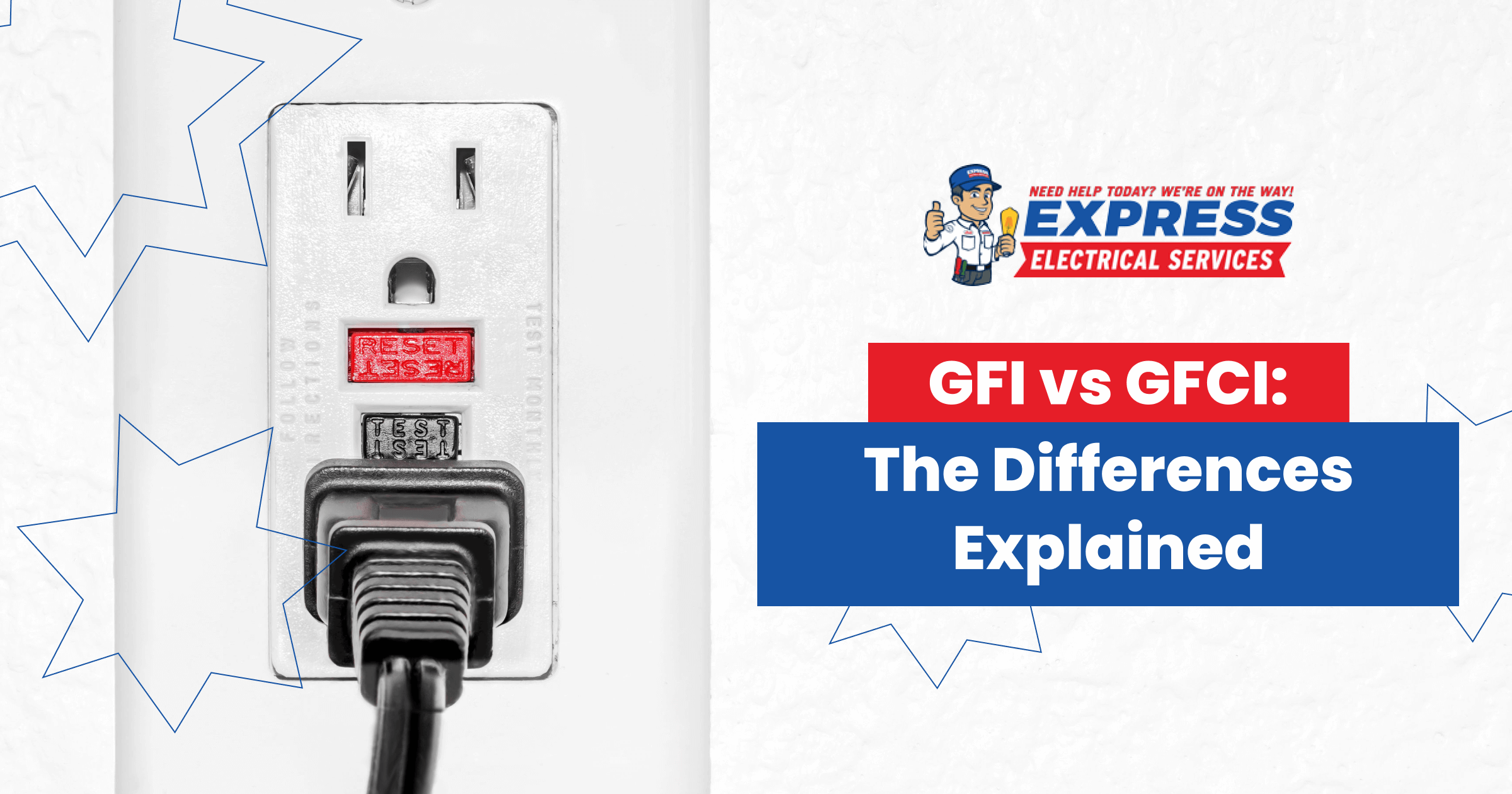GFI Outlets vs. GFCI Outlets: The Differences Explained

GFCI and GFI outlets are crucial electrical safety devices that protect your home from electrical hazards. Often referred to interchangeably, it can be tough to understand the differences between GFI outlets vs. GFCI outlets.
Learn about the distinctions and similarities between GFI and GFCI outlets, how they work, and when to use a GFCI or GFI outlet in your home. For GFCI/GFI installation and other services, rely on our team at Express Electrical for assistance.
What Are GFCI and GFI Outlets?
Ground fault circuit interrupters (GFCIs) and ground fault interrupters (GFIs) are devices that help protect your home against electrical hazards. They monitor, detect, and interrupt the flow of electricity in the event of abnormalities in the electrical current to reduce the risk of ground faults.
Functionally, GFCI and GFI outlets are minimally different and serve the same purpose, and it’s acceptable to use these terms interchangeably. However, electricians sometimes employ this terminology more specifically — GFCI refers to modern outlets and circuit breakers, which are more commonly known and essential for compliance with current electrical codes. In comparison, GFI outlets are older devices with the same function as GFCIs but are typically limited to a local receptacle or outlet. Most GFCI outlets are backward-compatible, meaning they can replace existing GFI outlets.

How they work
GFCI and GFI outlets are designed to prevent shocks, burns, or electrocution resulting from exposure to electric current. These devices continuously monitor the electrical current traveling through the circuit’s hot and neutral wires. If the current shows abnormalities, even varying 4 or 5 milliamps, it will trip and disconnect power using a built-in circuit breaker mechanism. Disconnection should only take a few milliseconds as rapid response is essential for avoiding injury.
GFCIs have test buttons that allow users to simulate a ground fault and verify proper function. Use this safety feature periodically to check the device’s operation — if it doesn’t work, your GFCI outlet may need repair or replacement. GFCI outlets also have a reset button, which restores power after a trip and resets the internal tripping mechanism.
Why Are GFI and GFCI Outlets Important for Electrical Safety?
GFI and GFCI outlets are essential for electrical safety anywhere that electrical current risks coming into contact with water. The National Electric Code (NEC) generally requires GFCI/GFI outlets anywhere with proximity to water, such as
- Bathrooms
- Kitchens
- Garages
- Outdoors
- Basements and crawl spaces
- Laundry areas
- Underwater pool lighting
In properly functioning electrical systems, electricity travels from Point A to Point B, but frayed or damaged wiring and other issues can sometimes cause the current to detour. In this case, the current will look for the fastest way to reach the ground, which can include people. The resulting shock can lead to significant and sometimes lethal injuries, and the risk of shock is even greater with proximity to water as it’s highly conductive and can connect rogue currents with nearby people.
Can I Install a GFCI or GFI Outlet Myself?
Homeowners with electrical understanding can sometimes perform minor installations, repairs, or upgrades, but working with electricity can be dangerous without the right skills and knowledge. In most cases, it’s best to rely on a licensed electrician who can ensure proper GFCI outlet safety, function, and peace of mind.
If you’re qualified to install a GFCI or GFI outlet, the process usually involves these steps:
- Turn off power: Disconnect power to the outlet from the electrical panel before starting work. Use a voltage meter to verify disconnection.
- Remove existing outlet: Unscrew the outlet cover plate and carefully remove the outlet from its electrical box in the wall.
- Connect wires: Following the manufacturer’s instructions, connect the wires to the corresponding terminals on the GFCI outlet.
- Complete installation: Tuck the wires into the box, secure the outlet with screws, and replace the cover plate. Use the test and reset button functions to verify correct installation and operation.
Contact Express Electrical Services
Serving Los Angeles and other California areas, Express Electrical Services specializes in GFCI/GFI outlet installation, repair, and replacement as well as other electrical services. Rely on our team of fully licensed, insured, and bonded electricians to provide safe and efficient installation. Take advantage of 24/7 live assistance, rapid response, and high-quality services, and learn why Los Angeles, Orange County, and other areas trust Express Electrical. Contact us or book online today.
Frequently Asked Questions
What should I do if a GFCI or GFI outlet trips?
If a GFCI or GFI trips, the device has likely detected a ground fault and interrupted the electrical circuit. Identify which GFCI tripped according to the circuits without power. Press the reset button on the GFCI outlet, which should click to indicate reconnection. Plug in a lamp or other small device to test for electricity.
Next, investigate the underlying cause to avoid further GFCI trips and keep your electrical system safe. Look for water or moisture near the outlets, overloaded circuits, faulty wiring, or other issues that can result in a trip. Contact an electrician if your electrical system requires repair or upgrade to handle your home’s power demand.
What causes a GFCI to fail?
GFCIs and GFIs provide reliable protection against ground faults and shocks. While uncommon, GFCIs can fail due to:
- General wear: GFCIs can wear out as they age, and exposure to moisture, impact, or other conditions can accelerate wear and result in malfunctioning tripping mechanisms.
- Incorrect wiring or installation: Installation errors and wiring problems, such as faulty connections to terminals, can prevent the GFCI from accurately detecting ground faults.
- Power surges: Electrical surges, such as from overloaded circuits or lightning, can permanently damage the GFCI’s internal mechanisms.
Regular testing and maintenance are necessary for avoiding GFCI failure. Routinely inspect and test your devices, and schedule inspection or repairs with licensed electricians if you suspect improper function.

Leave A Comment